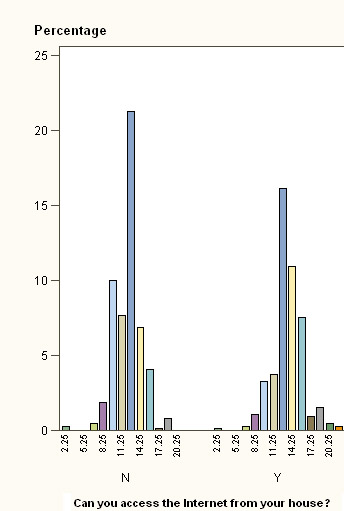Broadband on the Range
 I have way more pictures of buffalo than the normal person.
I have way more pictures of buffalo than the normal person.
I guess that comes from working for 19 years on the reservation. After reading on GigaOm about the $28 billion in rural broadband access, I decided I wanted to write a post on Internet access in rural communities, specifically, the data we have on the Great Plains reservations. To illustrate it, I thought I would use a picture of a buffalo, which is the point where I realized that I have pictures of buffalo in the summer, in the winter, in groups, all alone and wearing a tu-tu. But I digress. Actually, this whole blog is a digression.
We collected these data over a period of several years ending in 2008 when funding agencies quit paying us to do this and started paying us to do something else. Actually, by that point we were also coming to the conclusion that access to the Internet on the reservations was becoming less of an issue in terms of the hardware and more of an issue in terms of content.
Over the four years or so of data collection we surveyed 701 people on Indian reservations in the Great Plains states, mostly in North Dakota, but also including South Dakota, Montana and Minnesota, with a few odd visitors from other reservations and regions thrown in who happened to be attending pow-wows in the area and were kind enough to give us their time and opinions. To give you some idea of the rural nature of the reservation, the picture above was taken half a mile from the center of the largest town on the Spirit Lake Nation. The respondents were pretty representative of the general population on the reservation; 57% of them had a high school education or less.
Interestingly, we found that nearly half (49.8%) of people on the reservations we surveyed had a home computer, and almost as many (47%) had home internet access. I was curious to see if there were differences between those who did and did not have home internet access. There was, but not as much as I expected. Those without internet access, on the average had 11.9 years of education, or a little less than high school, while those who did have internet access had an average of 13.2 years of education. For those of you who follow these things, the difference was statistically significant (p <.0001) and there was also a significant difference in variance.
 As you can see from the graph, people who did not have internet access were far more likely to be high school graduates or less, while the people who had at least some college, even just a year or two, were far more likely to have internet access at home.
As you can see from the graph, people who did not have internet access were far more likely to be high school graduates or less, while the people who had at least some college, even just a year or two, were far more likely to have internet access at home.
Near the end of the project, broadband access became available on the reservations. So, we began asking how many people had broadband acccess. We also asked how many people knew what broadband was. Since this was near the end of the project, we only asked about 10% of the people we surveyed. Guess what? By the end of 2007, about half of the people we surveyed on the reservation knew what broadband access was and those 50% reported having broadband access. We did not ask if they had it at work or at home, which, in retrospect, might have been a good question.
So, what difference does it all make and why is your government spending $28 billion on it?
Well, that is a very good question, but since it is past 11 pm and I have a glass of Chardonnay waiting for me, it will have to wait until tomorrow (the answer, not the Chardonnay, which I am going to attend to right now).